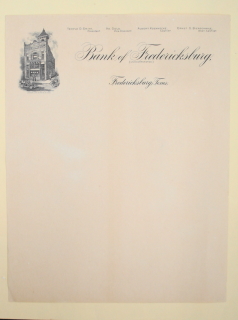This artifact is a single sheet of stationery used by the Bank of Fredericksburg in Texas. The seal, dated with the year 1900 in the upper left corner of the page denotes the name Temple D. Smith, the bank’s president at that time. The actual town of Fredericksburg was founded in 1848 by John O. Meusebach. The town existed without a bank until Temple Smith founded the Bank of Frederickburg in 1887. Mr. Smith had recently moved to San Antonio from Indiana, and when he arrived he learned that the small town of Fredericksburg needed a bank and took it upon himself to move north.
Fredericksburg had grown quite a bit by that time: the city had built a wagon road to Austin, established the Meuseback-Comanche Treaty to ward off Indian attacks, completed the construction of the Vereins-Kirche (translated to mean “Society Church”), and signed the Treaty of Guadalupe Hidalgo[7] all before 1850. Because the town was primarily full of German immigrants, World War II proved to be a challenging time. The residents refused to become involved in state or national affairs, and instead took to living a happy, independent, and peaceful German lifestyle. Most of the town refused to learn or use English, and even their newspaper, the Fredericksburg Wochenblatt was written entirely in German; it was the first German-language newspaper ever printed in the country.
Smith established the Bank of Fredericksburg in the Edward Maier Building in 1887, but erected a two-story building two years later once his institution had become more financially established. Deciding to expand his market, in 1894 Smith organized and was president of the First National Bank of Carthage. Three years later he built the Cotton Belt State Bank of Timpson. He was a significant part of the movement to construct a railroad between Fredericksburg and San Antonio, which became known as the Fredericksburg Northern Railway. A town by the name of Bankersmith (named in honor of Temple Smith), opened up along the railroad line and at its peak in the 1920s boasted a population of nearly fifty people. The first train rolled into Fredericksburg on November 17, 1913; the last on July 25, 1942. It was closed due to competition from the much more efficient roads and automobiles becoming ever more prominent in the era.
Smith passed away in 1926 in San Antonio. Today, Fredericksburg is primarily a tourist destination with quaint bed-and-breakfasts, tasty wineries, and beautiful outdoor parks that are still significantly influenced by German culture. The town has an excellent array of small shops with everything from household trinkets, to clothing, to custom candles made in the store right in front of your eyes. It is also known for its extravagant display of Christmas lights during the holidays.
